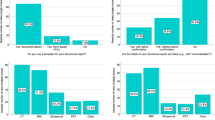Abstract
The article is part of the series of articles on radiation protection. You can find further articles in the special section of the CVIR issue. Lately, more advanced techniques have been introduced in medical imaging expanding the diagnostic and therapeutic applications of ionizing radiation. Among the various strategies that have been proposed for the management of radiation exposure, education and training seem to have a strong impact on radiation protection and dose reduction. However, according to several studies, medical professionals appear to lack knowledge on basic radiation protection aspects. Therefore, the establishment of an accreditation and certification system in radiation protection for all medical professionals employing ionizing radiation is considered as high priority. The purpose of this review article is to highlight the importance of education and training in radiation protection, provide recommendations for an effective educational program and propose an educational program structure for the different medical specialties.
Similar content being viewed by others
References
UNSCEAR. UNSCEAR 2008 Report. Sources and effects of ionizing radiation. Volume I: Sources: Report to the General Assembly, Scientific Annexes A and B. UNSCEAR 2008 Report. United Nations Scientific Committee on the Effects of Atomic Radiation. New York: United Nations; 2010. https://eur-lex.europa.eu/LexUriServ/LexUriServ.do?uri=OJ:L:2014:013:0001:0073:EN:PDF.
European Council Directive 2013/59/Euratom on basic safety standards for protection against the dangers arising from exposure to ionising radiation and repealing Directives 89/618/Euratom, 90/641/Euratom, 96/29/Euratom, 97/43/Euratom and 2003/122/Euratom. OJ of the EU. L13; 57: 1–73 (2014).
Guidelines on radiation protection education and training of medical professionals in the European Union (2014), publication no. 175, European Commission. Available at https://ec.europa.eu/energy/sites/ener/files/documents/175.pdf.
Vañó E, Rosenstein M, Liniecki J, Rehani MM, Martin CJ, Vetter RJ. ICRP Publication 113. Education and training in radiological protection for diagnostic and interventional procedures. Ann ICRP. 2009;39(5):7–68. https://doi.org/10.1016/j.icrp.2011.01.002.
ICRP. ICRP statement on tissue reactions/early and late effects of radiation in normal tissues and organs—threshold doses for tissue reactions in a radiation protection context. ICRP Publication 118. Ann ICRP. 2012;41(1/2). Available at: https://www.icrp.org/publication.asp?id=ICRP%20Publication%20118.
Koenig TR, Wolff D, Mettler FA, Wagner LK. Skin injuries from fluoroscopically guided procedures. AJR. 2001;177(1):3–11.
Jaschke W, Schmuth M, Trianni A, Bartal G. Radiation-induced skin injuries to patients: what the interventional radiologist needs to know. Cardiovasc Interv Radiol. 2017;40(8):1131–40.
Junk AK, Haskal Z, Worgul BV. Cataract in interventional radiology—an occupational hazard? Investig Ophthalmol Vis Sci. 2004;45(13):388.
Barnard SG, Ainsbury EA, Quinlan RA, Bouffler SD. Radiation protection of the eye lens in medical workers-basis and impact of the ICRP recommendations. Br J Radiol. 2016;89(1060):20151034.
Elmaraezy A, Ebraheem Morra M, Tarek Mohammed A, et al. Risk of cataract among interventional cardiologists and catheterization lab staff: a systematic review and meta-analysis. Catheter Cardiovasc Interv. 2017;90(1):1–9. https://doi.org/10.1002/ccd.27114.
Vanhavere F, Carinou E, Gualdrini G, et al. ORAMED: optimization of radiation protection for medical staff. 7th EURADOS Report 2012. ISSN 2226-8057. ISBN 978-3-943701-01-2. Available at: https://cordis.europa.eu/project/id/211361/reporting.
El-Sayed T, Patel AS, Cho JS, Kelly JA, Ludwinski FE, Saha P, et al. Radiation-induced DNA damage in operators performing endovascular aortic repair. Circulation. 2017;136(25):2406–16.
Ramanathan S, Ryan J. Radiation awareness among radiology residents, technologists, fellows and staff: where do we stand? Insights Imaging. 2015;6:133–212.
Van Papendorp LWA, Suleman FE, Hanekom H. The knowledge, awareness and practices of radiation safety amongst orthopaedic surgeons. SA J Radiol. 2020;24(1):1806. https://doi.org/10.4102/sajr.v24i1.1806.PMID:32161676;PMCID:PMC7059512.
Vano E, Ubeda C, Miranda P, Leyton F, Durán A, Nader A. Radiation protection in pediatric interventional cardiology: an IAEA PILOT program in Latin America. Health Phys. 2011;101(3):233–7. https://doi.org/10.1097/HP.0b013e3182135fd1.
Ribeiro A, Husson O, Drey N, et al. Ionising radiation exposure from medical imaging—a review of Patient’s (un) awareness. Radiography. 2020;26(2):e25–30.
Schindera ST, Treier R, von Allmen G, et al. An education and training programme for radiological institutes: impact on the reduction of the CT radiation dose. Eur Radiol. 2011;21(10):2039–45.
Hojreh A, Weber M, Homolka P. Effect of staff training on radiation dose in pediatric CT. Eur J Radiol. 2015;84(8):1574–8.
Barakat MT, Thosani NC, Huang RJ, et al. Effects of a Brief educational program on optimization of fluoroscopy to minimize radiation exposure during endoscopic retrograde cholangiopancreatography. Clin Gastroenterol Hepatol. 2018;16(4):550–7.
IAEA, Online training in radiation protection. Available at: https://www.iaea.org/resources/rpop/resources/online-training.
ESR Eurosafe Imaging, Available at: http://www.eurosafeimaging.org/training.
Radiation Safety Cases. Available at: https://www.imagewisely.org/Educational-Tools/Radiation-Safety-Cases.
Image Gently Alliance. Available at: https://www.imagegently.org/education#1882682-online-educational-modules.
European Commission. Radiation Protection NO 174: European guidelines on medical physics expert, Directorate-General for Energy. 2014. https://doi.org/10.2833/18393. Available at: https://ec.europa.eu/energy/sites/ener/files/documents/174.pdf.
Bott OJ, Dresing K, Wagner M, Raab BW, Teistler M. Informatics in radiology: use of a C-arm fluoroscopy simulator to support training in intraoperative radiography. Radiographics. 2011;31(3):E65–75. https://doi.org/10.1148/rg.313105125.
Miglioretti DL, Smith-Bindman R. Overuse of computed tomography and associated risks. Am Fam Phys. 2011;83(11):1252–4.
Smith-Bindman R. Is computed tomography safe? N Engl J Med. 2010;363(1):1–4. https://doi.org/10.1056/NEJMp1002530.
U.S. Food and Drug Administration. Initiative to reduce unnecessary radiation exposure from medical imaging. Center for Devices and Radiological Health, 2010. Available at: https://www.fda.gov/radiationemitting-products/radiation-safety/initiative-reduce-unnecessary-radiation-exposure-medical-imaging.
Cascade PN. The American College of Radiology. ACR appropriateness criteria project. Radiology. 2000;214(Suppl):3–46.
Clinical decision support for European imaging referral guidelines, ESR. Available at: http://www.eurosafeimaging.org/information-for-referring-professionals-2/clinical-decision-support.
Remedios D. et al. Radiation Protection. No. 178: Referral Guidelines for Medical Imaging Availability and Use in the European Union. Directorate-General for Energy, Luxembourg. 2014. https://doi.org/10.2833/18118.
Funding
This study was not supported by any funding.
Author information
Authors and Affiliations
Corresponding author
Ethics declarations
Conflict of interest
The authors declare that they have no conflict of interest.
Ethical Approval
This article does not contain any studies patients or animals performed by any of the authors.
Informed Consent
For this type of study, informed consent is not required.
Consent for Publication
For this type of study, consent for publication is not required.
Additional information
Publisher's Note
Springer Nature remains neutral with regard to jurisdictional claims in published maps and institutional affiliations.
Rights and permissions
About this article
Cite this article
Ploussi, A., Efstathopoulos, E.P. & Brountzos, E. The Importance of Radiation Protection Education and Training for Medical Professionals of All Specialties. Cardiovasc Intervent Radiol 44, 829–834 (2021). https://doi.org/10.1007/s00270-020-02744-7
Received:
Accepted:
Published:
Issue Date:
DOI: https://doi.org/10.1007/s00270-020-02744-7



